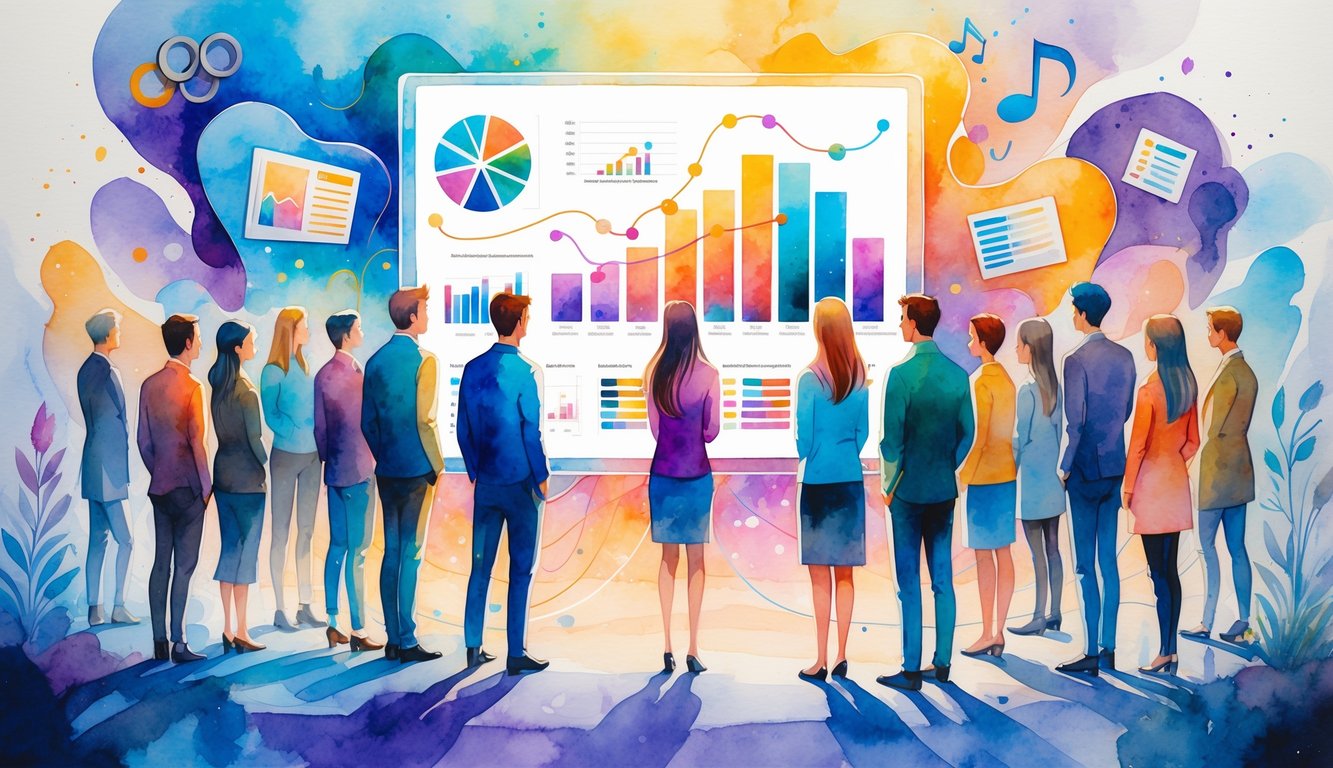
Viewer Behavior and Consumption Patterns
Nobody told me how deep these viewer data rabbit holes go. I’m drowning in heatmaps and scatterplots—32% of people start a new sci-fi series between 8:15 and 9:00 p.m., but a bunch of them bail to watch old cooking shows. The numbers don’t even try to make sense.
Binge-Watching and Content Consumption Habits
Daily chaos. I swear I’ll just watch one episode, then it’s 3 a.m. and my coffee’s cold. Nielsen said binge-watching doubled among Gen Z last year. Parrot Analytics clocked “must-watch” weekends at 120+ minutes per session. Not because anyone wants to, but because the algorithm shames you into it.
Does anyone actually pace themselves? Doubt it. My brother claims he’s immune, but he texts me plot twists at 2 a.m. from a show he “just started.” You can chart all the patterns you want—still won’t predict what anyone’s watching next.
Influence of Streaming Platforms
Here’s what kills me: Netflix, Disney+, all of them—they decide what I watch. Deloitte’s 2025 report (yeah, I skimmed it) says their homepage boosts some shows by 240% just by putting them up front. Genre preference? Meaningless if you never see half the options.
Trending charts are basically marketing stunts. Ever notice a random old sitcom suddenly trending? That’s not nostalgia, it’s a push. Hulu’s data (from a webinar I half-watched) said horror promos before October doubled new sign-ups. Not because people suddenly love horror—just inertia and UI tricks.
Some platforms punish binge-watching—Apple TV+ drops episodes weekly and acts like it’s a moral crusade. Try explaining that to someone raised on auto-play. Platform control is way deeper than anyone admits.
The Rise of Personalized Content
Recommendation engines? Don’t get me started. I watched one Norwegian architecture doc, and now my feed is all fjords and concrete. Pew says 78% of people expect their picks to match their secret genre cravings. Netflix’s tech chief brags about “2,000 discrete attributes”—whatever that means. My list is creepily accurate, or maybe I’m just giving in.
Are we really discovering new genres, or just following the path the platform lays out? My “thriller superfan” label is a joke—I slept through half those shows. Personalized content isn’t a feature, it’s the whole system now, even if it never quite nails it.
Unlocking Insights Through Advanced Audience Analytics
Who actually knows what viewers want? Focus groups contradict their own surveys. Audience analytics dashboards spit out micro-genres I’ve never heard of, and the data team swears there’s millions in it. Missing the weird reasons someone jumps from horror to rom-com is how marketing budgets explode.
Data Analytics and Qualitative Research
AI dashboards, heatmaps, whatever—they never tell the whole story. Nielsen said retro sitcom viewing spiked 14%, and their sentiment bots called it “escapism.” My Twitter feed said “anxiety.” I trust human context way more than any dashboard.
A Chief Research Officer once told me face-to-face interviews catch what digital tracking misses. Mixing those results is always chaos. I worked with a studio that mashed up streaming metrics and focus groups—what surfaced? Not a hidden genre, just complaints about marketing language nobody reads. Nobody brags about that in case studies, but it changes what actually gets made.
Sometimes, qualitative and quantitative signals just fight. The only way to make sense of it is to let creative execs argue until someone gives up. No algorithm ever pulled me aside to debate if “edgy mystery romance” is horror or just a tax dodge.
Audience Analytics for Targeting Content
I used to laugh at predictive targeting. Then I watched an indie sci-fi film’s campaign crush a blockbuster, just because the data team tagged the right audience. FOX’s analytics guy, Mainak Mazumdar, nailed it—people hop devices, so attribution is a mess. Parrot Analytics uses machine learning to track sentiment shifts after every episode, and it’s a data avalanche: geography, genre drift, time-of-day, whatever.
If you’re still building campaigns by “males 25-34,” just stop. I go by consumption patterns now—binge vs. weekly, Reddit vs. Instagram chatter. My secret weapon? Custom metadata tags—character types, theme triggers, the works. Tried it on a mid-budget Mexican drama, found a whole new segment: Gen Z horror fans who hate gore. Go figure.
Most teams miss the “hidden” clusters algorithms can surface if you bother cross-referencing multiple datasets. And, not for nothing, internal politics over who gets credit usually wrecks the best targeting plans.
Privacy Concerns with Data Collection
This is the part that actually freaks me out: privacy. GDPR, CCPA, and now a new regulation every month—keeping up is a nightmare. I’ve watched a data officer swear “it’s all anonymized,” then two days later, their segments re-identified a superfan by accident. Not rare.
Every new tech—cookie replacements, device graphs, whatever—just adds new privacy holes. I flag risk every time we map cross-device behavior. I’ve seen a platform pivot overnight after user backlash on opt-in. Engagement tanks for a month, but trust bounces back.
Experts at every conference repeat the same thing: if you don’t build in transparency and consent, analytics will nuke your reputation. My go-to advice now? Build privacy guardrails first. Otherwise, the only thing you’re unlocking is churn.
Impact of Technological Advancements on Viewer Preferences
Nobody ever talks about how these algorithms guess what I’ll binge next before I even know, or how my feed explodes with memes the second I try to look up something simple. The tech isn’t just behind the screen—it’s rewiring what we even think we like.
Role of Technology in Personalization
Algorithms. Seriously, I can’t tell if Netflix is psychic or just totally off its rocker—why am I getting rare fruit documentaries after a cooking binge? Whatever. Nielsen’s 2023 Streaming Report says 84% of us mostly click on “personalized” sliders, but I’m not buying the magic. Sometimes I swear it’s just recycling stuff I barely tolerated.
Machine learning, collaborative filtering, “dynamic user profiling”—yeah, that’s the jargon, but it’s not just for show. Apple TV+ is all over it, Disney+ too, and nobody even blinks when their recommendations get weird after a friend borrows their login. My UX friend insists Netflix watches everything, even when you pause or rewind. Creepy, maybe, but it does keep me from doom-scrolling forever. Still, do these things shape what I like, or just trap me in a feedback loop? No clue. Feels like my queue is just a messy echo of every random click I’ve ever made.
User-Generated Content and Fan Communities
Reddit, TikTok, Discord—I’m lost in these fan holes every week. Last night, I blinked and an hour disappeared to TikTok edits from a show I never even finished. There’s user content everywhere: reaction videos, ranking threads, fanfic (Archive of Our Own had, what, over 40 million visits last month? That’s what SimilarWeb claims).
Communities pop up overnight. Discord for premieres, stan fights on X, YouTubers getting awards just for recaps. Honestly, nobody cares if your video is ugly as long as you’re saying something sharp. Variety’s analysts say over 60% of younger viewers care more about fan-made stuff than official promos. Peer reviews change my watchlist faster than any billboard ever could. But, yeah, sometimes fandoms get hijacked by the loudest people (spoiler trolls, anyone?). I wish streaming apps just built in fan hubs already—I’m tired of juggling tabs—but I get why they don’t. Ads, right?



